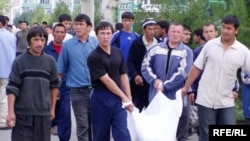These days, Uzbekistan is in the news more for its shared border with Afghanistan than its human rights abuses. A new documentary by Danish journalist Michael Andersen aims to change that.
“Massacre In Uzbekistan: Foretold, Forgiven, Forgotten” sheds new light on the tragic events of May 13, 2005, when government forces opened fire on protesters in the city of Andijon in eastern Uzbekistan.
More than seven years on, there is no shortage of literature about the events in Andijon. Groups like Human Rights Watch and Amnesty International have published hundreds of pages of eyewitness accounts and details of the violence -- and the closed mass trials following it. But, according to Anderson, the whole story has not been told until now.
WATCH: Trailer for "Massacre In Uzbekistan"
Speaking with RFE/RL, Andersen says his documentary is the only film that “has followed this situation since Andijon.” Through a score of exclusive, never-before-seen interviews with eyewitnesses, viewers are given “the whole nasty, sad story.”
One of the main points of contention (there are many) is the death count from the violence. The Uzbek government has long maintained that 187 people were killed in the Andijon violence and that they were all “terrorists” with aims of overthrowing the government and setting up an Islamic caliphate. Some outside estimates put the number of dead closer to 1,000, with countless more wounded. Andersen says the film's producers were shown “copies of death certificates from the morgue [in Andijon] showing that the Karimov story of '187 people died and they were all terrorists' is a very clear lie.”
Andersen likens the events in Andijon -- and the Western world’s dealings with the Karimov government -- to a literary work. The events in Andijon are where things start, Western sanctions ostensibly related to the violence are the middle, and the rapprochement of the last few years -- mainly related to Uzbekistan’s rail link to Afghanistan -- serve as the “bittersweet end.”
It may be a tragic a story, but Andersen tries to remain an optimist.
“When you look at Andijon over seven years, one of the things you learn is that there are a hell of a lot of heroes in this story,” he says. “Uzbek human rights activists, defenders, people who have suffered...they risk their lives to speak out. It’s awe-inspiring.”
-- Zach Peterson
“Massacre In Uzbekistan: Foretold, Forgiven, Forgotten” sheds new light on the tragic events of May 13, 2005, when government forces opened fire on protesters in the city of Andijon in eastern Uzbekistan.
More than seven years on, there is no shortage of literature about the events in Andijon. Groups like Human Rights Watch and Amnesty International have published hundreds of pages of eyewitness accounts and details of the violence -- and the closed mass trials following it. But, according to Anderson, the whole story has not been told until now.
WATCH: Trailer for "Massacre In Uzbekistan"
Speaking with RFE/RL, Andersen says his documentary is the only film that “has followed this situation since Andijon.” Through a score of exclusive, never-before-seen interviews with eyewitnesses, viewers are given “the whole nasty, sad story.”
One of the main points of contention (there are many) is the death count from the violence. The Uzbek government has long maintained that 187 people were killed in the Andijon violence and that they were all “terrorists” with aims of overthrowing the government and setting up an Islamic caliphate. Some outside estimates put the number of dead closer to 1,000, with countless more wounded. Andersen says the film's producers were shown “copies of death certificates from the morgue [in Andijon] showing that the Karimov story of '187 people died and they were all terrorists' is a very clear lie.”
Andersen likens the events in Andijon -- and the Western world’s dealings with the Karimov government -- to a literary work. The events in Andijon are where things start, Western sanctions ostensibly related to the violence are the middle, and the rapprochement of the last few years -- mainly related to Uzbekistan’s rail link to Afghanistan -- serve as the “bittersweet end.”
It may be a tragic a story, but Andersen tries to remain an optimist.
“When you look at Andijon over seven years, one of the things you learn is that there are a hell of a lot of heroes in this story,” he says. “Uzbek human rights activists, defenders, people who have suffered...they risk their lives to speak out. It’s awe-inspiring.”
-- Zach Peterson




